University of Innsbruck
| Leopold-Franzens-Universität Innsbruck | |
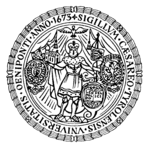 | |
| Latin: Universitas Leopoldino Franciscea, also called Alma Mater Oenipontana | |
| Type | Public |
|---|---|
| Established | 1669 (as a university) |
| Rector | Tilmann Märk |
Academic staff | 3,164 (227 professors) |
Administrative staff | 1,383 |
| Students | 27,774 |
| Location |
Innsbruck, Austria 47°15′46″N 11°23′4″E / 47.26278°N 11.38444°ECoordinates: 47°15′46″N 11°23′4″E / 47.26278°N 11.38444°E |
| Campus | Urban |
| Website |
www |
The University of Innsbruck (German: Leopold-Franzens-Universität Innsbruck; Latin: Universitas Leopoldino Franciscea) is a public university in Innsbruck, the capital of the Austrian federal state of Tyrol, founded in 1669.
It is currently the largest education facility in the Austrian Bundesland of Tirol, the third largest in Austria behind Vienna University and the University of Graz and according to The Times Higher Education Supplement World Ranking 2010 Austria's leading university. Significant contributions have been made in many branches, most of all in the physics department. Further, regarding the number of Web of Science-listed publications, it occupies the third rank worldwide in the area of mountain research.[1]
History
In 1562 a Jesuit grammar school was established in Innsbruck by Peter Canisius, today called "Akademisches Gymnasium Innsbruck". It was financed by the salt mines in Hall in Tirol, and was refounded as a university in 1669 by Leopold I with four faculties. In 1782 this was reduced to a mere lyceum (as were all other Universities in the Austrian Empire, apart from Prague, Vienna and Lviv), but it was reestablished as the University of Innsbruck in 1826 by Emperor Franz I. The university is therefore named after both of its founding fathers with the official title "Leopold-Franzens-Universität Innsbruck" (Universitas Leopoldino-Franciscea).
In 1991 Lauda Air Flight 004 crashed in Thailand, killing all aboard, including 21 members of the University of Innsbruck. The passengers included professor and economist Clemens August Andreae, another professor, six assistants, and 13 students. Andreae had often led field visits to Hong Kong.[2]
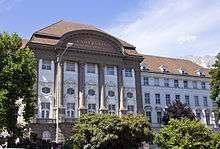
In 2005, copies of letters written by the emperors Frederick II and Conrad IV were found in the university's library. They arrived in Innsbruck in the 18th century, having left the charterhouse Allerengelberg in Schnals due to its abolishment.
Ceremonial Equipment
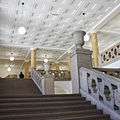

In the 1850s, the Habsburgs gradually closed the University of Olomouc as a consequence of the Olomouc students' and professors' participation in the 1848 revolutions and the Czech National Revival. The ceremonial equipment of the University of Olomouc was then transferred to the University of Innsbruck. The original Olomouc ceremonial maces from the 1580s are now used as the maces of Innsbruck University and Innsbruck Medical University. Olomouc University Rector's mace from ca. 1572 is nowadays used as the mace of the Innsbruck Faculty of Theology and Olomouc Faculty of Law Dean's Mace from 1833 is nowadays used as Innsbruck's Faculty of Law Mace.[3]
Since the establishment of Czechoslovakia in 1918, the Czechs have been unsuccessfully requesting the return of the University of Olomouc's original ceremonial equipment. Many years later, in 1998, Innsbruck donated an exact copy of the Rector's Mace to Palacký University, but it is still, in 2015, using the Olomouc University original maces and other regalia as its own ceremonial equipment.[3]
The faculties
The new plan of organisation (having become effective on October 1, 2004) installed the following 16 faculties to replace the previously existing six faculties:
- Faculty of Architecture,
- Faculty of Biology,
- Faculty of Catholic Theology,
- Faculty of Chemistry and Pharmacology,
- Faculty of Economics and Statistics,
- Faculty of Education,
- Faculty of Technical Sciences (formerly Faculty of Engineering Science and before that Faculty of Civil Engineering),
- Faculty of Geography and Atmospheric Sciences,
- Faculty of Humanities 1 (Philosophy and History),
- Faculty of Humanities 2 (Language and Literature),
- Faculty of Law,
- Faculty of Mathematics, Computer Science and Physics,
- Faculty of Psychology and Sports science,
- School of Political Sciences and Sociology,
- School of Management,
- School of Education (teacher training).
As of 1 January 2004, the Faculty of Medicine was sectioned off from the main university to become a university in its own right. This is now called the Innsbruck Medical University (Medizinische Universität Innsbruck).
Buildings
The university buildings are spread across the city and there is no university campus as such. The most important locations are:
- Theology faculty was opened 1562 as a Jesuit School in 1766 and the University used buildings from the Jesuit church in the Leopoldsaal (the original university).
- In 1924, main building and the university library opened.
- 1969 the scientific faculty and the construction faculty in Hotting west was opened.
- 1976 construction began on "Geiwi tower" for the former Philosophy faculty, an addition to the main building.
- 1997 The Social Science faculty (built in the former Fenner barracks) was opened.
- 2012 Center of Chemistry and Biomedicine was opened.
- Several university clinics of the medical university in the area became Tyrolian national hospitals.
- Galery: University of Innsbruck
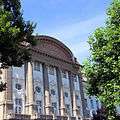 Main building
Main building In the main building
In the main building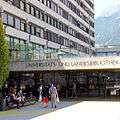 Library
Library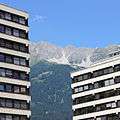 The Nordkette in the background
The Nordkette in the background- The Center of Chemistry and Biomedicine (CCB)
- The Center of Ancient Cultures
- The social sciences and economy faculty building
- Theology faculty building
- Reading room in the library
 Botanical Institute
Botanical Institute- Botanical Garden
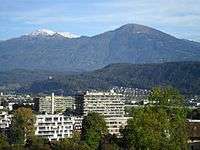 Physical science and biology faculty buildings
Physical science and biology faculty buildings
Points of interest
- Alpengarten Patscherkofel, the university's alpine garden atop Patscherkofel
- Botanischer Garten der Universität Innsbruck, the university's botanical garden
Nobel laureates
- Hans Fischer, Chemist (born 1881 Höchst a. M., died 1945 Munich)
- He was widely respected for his research on hemoglobin and chlorophyll, and on the synthesis of haemin. He also succeeded in explaining the constitution of chlorophyll. Fischer held chairs in Innsbruck (1916-18), Vienna (1918-21) and Munich (1921-1945). He won the Nobel Prize for Chemistry in 1930.
- Victor Francis Hess, Physicist (born 1883 Schloss Waldstein, died 1964 Mt. Vernon, U.S.A.)
- After studying in Graz he worked under Franz Exner at the Department of Physics in Vienna, becoming a Dozent in 1910 and an assistant at the new Institute of Radium Research. The discovery of cosmic radiation is particularly associated with him. Hess was appoined to Graz in 1920 and in 1931 to Innsbruck. In 1937 he returned to Graz but was forced to emigrate in 1938. He obtained a professorship at Fordham University in New York. He won the Nobel prize for Physics in 1936.
- Fritz Pregl, Physician and Chemist (born 1869 Laibach (Ljubljana), died 1930 Graz)
- He won the Nobel Prize in Chemistry in 1923 for making important contributions to quantitative organic microanalysis, one of which was the improvement of the combustion train technique for elemental analysis. From 1913 on he was professor of Medical Chemistry in Innsbruck for three years.
- Adolf Windaus, Chemist (born 1876 Berlin, died 1959 Göttingen)
- He won a Nobel Prize in Chemistry in 1928 for his work on sterols and their relation to vitamins. He was at the University of Innsbruck from 1916 till 1918 at the Institute of Medical Chemistry.
Notable faculty
- Clemens August Andreae, professor and economist[2]
Notable alumni
Alexander Van der Bellen, current President-elect of Austria
Victims of political persecution and terror
- Ludwig Wahrmund was professor of Canon Law in 1908 who was ousted from his post following critical remarks about the Catholic Church's interference in academic freedom.[4]
- Christoph Probst (born 6 November 1919 in Murnau am Staffelsee : executed 22 February 1943 in Munich) was a student of medicine and a member of the White Rose (Weiße Rose) resistance group.
- Ignacio Ellacuría, S.J. (Portugalete, Biscay, Spain, 9 November 1930 – San Salvador, 16 November 1989) was a Roman Catholic Jesuit priest, philosopher, and theologian. Ignacio Ellacuría was a close friend and colleague of the scholars Ignacio Martín-Baró and Segundo Montes, all of whom were assassinated with Ellacuría by the Salvadoran army, along with three colleagues and two employees. He earned his master's degree at Innsbruck University.
- Segundo Montes, S.J. (Valladolid, Spain, 15 May 1933 - San Salvador, El Salvador, 16 November 1989) was a scholar, philosopher, educator, sociologist and Jesuit priest. Segundo Montes was a close friend and colleague of the scholars Ignacio Martín-Baró and Ignacio Ellacuría, all of whom were murdered with Montes by the Salvadoran army, along with three other colleagues and two other employees. He earned his master's degree at Innsbruck.
- Kurt von Schuschnigg (1897-1977) was Austria chancellor and was imprisoned until 1945 after the anschluss (1938).
See also
External links
| Wikimedia Commons has media related to University of Innsbruck. |
- University of Innsbruck
- Innsbruck Medical University
- Universitäts- und Landesbibliothek Tirol
- Innsbruck University @ The Catholic Encyclopedia
References
- ↑ "Global Statistics of "Mountain" and "Alpine" Research". Mountain Research and Development. 29: 97–102. doi:10.1659/mrd.1108.
- 1 2 "Im Gedenken an den Flugzeugabsturz 1991." (Archive) University of Innsbruck. Retrieved on 15 February 2013. "223 Menschen, darunter 21 Angehörige der Universität Innsbruck, kamen beim Absturz der Boeing 767, die am 26. Mai 1991 nach einem Zwischenstopp von Bangkok Richtung Wien gestartet war, ums Leben. Neben dem bekannten Wirtschaftswissenschaftler Prof. Clemens August Andreae, der die finanzwissenschaftliche Exkursion nach Hongkong geleitet hatte, waren ein weiterer Professor, sechs Assistentinnen und Assistenten und 13 Studierende an Bord des Unglücksfliegers, der aufgrund einer defekten Schubumkehr nur 15 Minuten nach dem Abflug in den Thailändischen Dschungel stürzte."
- 1 2 Fiala, Jiří (12 July 1998). "Původní žezlo rektora olomoucké univerzity [Original mace of Olomouc University's Rector]" (PDF). Žurnál Univerzity Palackého (in Czech). Olomouc: Palacký University of Olomouc. 7 (28). Retrieved 30 December 2012.
- ↑ Geehr, Richard S. (1990). Karl Lueger: Mayor of Fin de Siècle Vienna. Wayne State University Press.